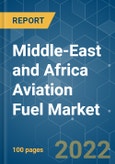The aviation fuel market in Middle-East and Africa is expected to grow at CAGR of more than 13% in the forecast period of 2020-2025. The increasing number of air passengers, on account of the cheaper airfare in recent times, stronger economic conditions, and increasing disposable income are among the major driving factors for the market. With ongoing and upcoming fighter jet deals in different countries in the region is also expected to increase aviation fuel demand further. However, the recent outbreak of COVID-19 has tremendously affected the consumption of aviation fuel. With the closure of international and domestic airlines to curb the spread of the virus, the demand for aviation fuel is expected to decline during the pandemic.
Key Highlights
- With increasing connectivity globally and decreasing airfares, the commercial sector is expected to dominate the aviation fuel market during the forecast period.
- Countries in the Middle-Eastern region need over 2,600 new aircraft in the next 20 years, to cater to the increasing number of air travelers in the region. With this, large scale opportunities are expected for the aviation fuel market players also.
- With the largest market size in the Middle-East and Africa, the United Arab Emirates is leading the market in the region and is likely to continue its dominance.
Key Market Trends
Commercial Sector to Dominate the Market
- Commercial aviation includes operating scheduled and non-scheduled aircraft, which involves commercial air transportation of passengers or cargo. The commercial segment is one of the largest consumers of aviation fuel, and it accounts for a quarter of total operating expenditure for an airline operator.
- The number of passengers that have passed through Saudi Arabia’s airports in 2018 was 99.86 million, traveling by a total of 771,829 flights, through the Kingdom’s international and domestic airports. International airports.
- Furthermore, international airports have reached 97.3 million passengers, while the number of flights has reached 741,893 passengers
- Qatar airline launched 11 new destinations during the fiscal year 2019, and the airline’s fleet grew by 25 aircraft registering a total of 250 aircraft in March 2019 (Qatar Airways Annual Report). With more than 300 aircraft on order, the aviation fuel demand is expected to increase during the forecast period.
- In 2019, South Africa witnessed the highest air traffic in Africa, with total annual jet fuel consumption of about 2,438.85 billion liters. Besides, Jet fuel consumption and aviation gasoline consumption also rose by 4% in 2019 and reached 10.65 billion liters.
- However, due to the COVID-19 outbreak situation, countries like South Africa have banned flights from high-risk countries, including Germany, China, the United States, Iran, Italy, etc. This, in turn, is expected to restraint the aviation fuel market in region as Middle-East countries serve the hub for international connecting flights.
The United Arab Emirates to Dominate the Market
- The UAE’s national carriers fly to 108 countries and 224 cities around the world, and the value of the UAE’s investments in the aviation sector amounted to USD 270 billion, as of October 2019 (ICAO).
- The United Arab Emirates is among the leading countries in terms of the number of passengers passing through the national airports in 2018, accounting for 134 million passengers, with Dubai Airport ranking first, globally, in terms of the number of passengers in 2018, with over 89 million passengers (Dubai Statistics Centre).
- Moreover, once the Al Maktoum International Airport in Dubai is completed, it is expected to emerge as the largest airport in the world, with a capacity of up to 160 million passengers and 12 million metric tons of air freight volume annually.
- A total of 883,000 flights were handled by Emirati airports, with Dubai Airport ranking sixth, globally, in terms of shipment, transporting 68.65 million kg of goods (Dubai Airport Factsheet). The United Arab Emirates has one of the largest fleets of Boeing aircraft in the world, with 191 aircraft, and it also has 119 Airbus 380 aircraft. Its four national carriers have approximately 498 aircraft.
- In January 2019, Etihad Airways emerged as the first airline to fly a passenger flight using a biofuel made from plants grown in a desert. The flight from Abu Dhabi to Amsterdam used biofuel derived from a plant named Salicornia bigelovii, which grows in brackish water, and was fertilized using fish.
- However, the COVID-19 pandemic led to travel restrictions for flights to and from the United Arab Emirates. In the period between April-June 2020, the number of scheduled flights was about 79% less compared to the previous year (OAG). Hence, the demand for aviation fuel decreased, in turn, impeding market growth.
Competitive Landscape
The Middle-East and Africa aviation fuel market is moderately consolidated. Some of the major companies include Emirates National Oil Company, Chevron Corporation, Royal Dutch Shell PLC, Total SA, Abu Dhabi National Oil Company, and others.
Additional Benefits:
- The market estimate (ME) sheet in Excel format
- 3 months of analyst support
This product will be delivered within 2 business days.
Table of Contents
Methodology

LOADING...








